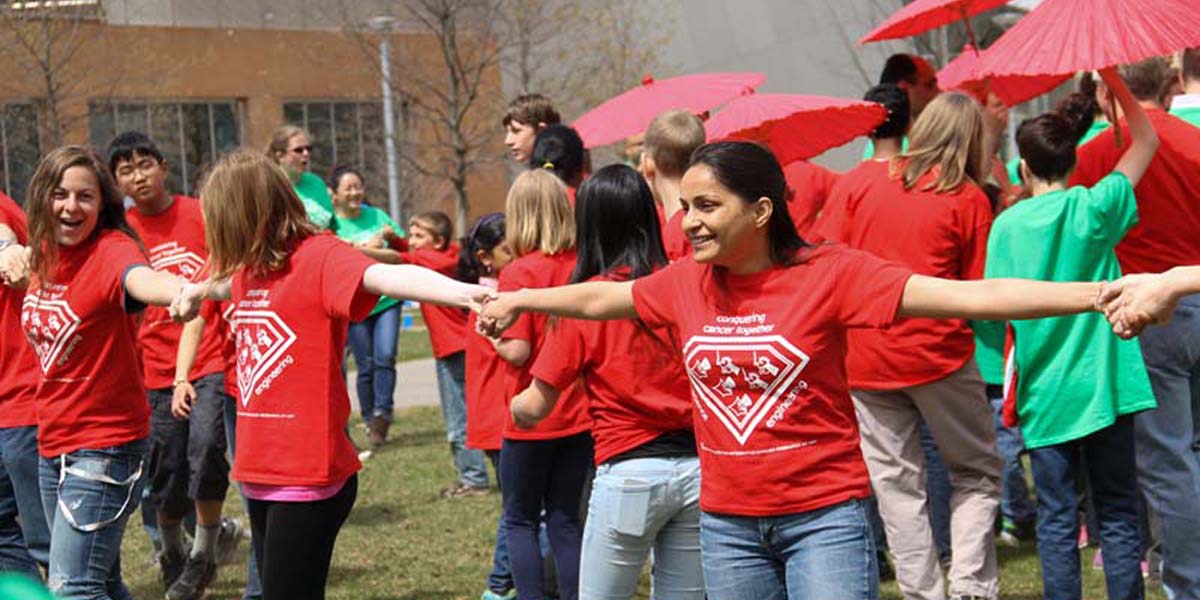

MIT Koch Institute
July 14, 2014
by Jennifer Lu, Technical Assistant, Langer Lab
Judging by the oversized foam fingers, color-coordinated T-shirts, and exuberant refrains of Queen's "We Will Rock You" emanating from the sidelines, the casual observer might assume the crowd outside the Koch Institute for Integrative Cancer Research was gathered for some kind of sporting event. In actual fact, they were celebrating the demise of a cancerous tumor by T-cells in the Koch Institute’s third annual biology-themed flash mob.
The event, Bio Flash 3: Immune Cells Fight Cancer, hosted by the KI as part of the weeklong Cambridge Science Festival held over April vacation, brought together 180 participants, including school children, their families, and researchers from the KI and wider MIT community. Participants were sorted into groups by the T-shirt they picked—purple for scientists, green for healthy cells, red for cancer cells, and blue for T-cells, the protagonists of this flash mob. Admitted one researcher wearing blue, "they told me I had to wave pompons, and I thought, sure, I can do that." Meanwhile, another scientist, who studies mutations in DNA repair pathway, felt obligated to wear red, because he works on cancer.
After opening remarks by public outreach coordinator and event emcee Erika Reinfeld, Cary Opel, a graduate student from the KI’s Wittrup laboratory, used cartoons and allusions to medieval warfare to tell the tale of cancer immunotherapy—harnessing the immune system to fight cancer. If our bodies were castles and T-cells their knights, he explained, then cancer would be the malignant knaves who infiltrate the body’s defenses. However, thanks to breakthroughs in cancer research, scientists have developed a secret weapon: the ability to extract a patient’s own T-cells, upgrade them, multiply them into an army of super T-cells, and transfuse them back into the patient.
This technology, called adoptive cell transfer, can enhance T-cell function in two ways. One approach modifies the receptors on the surface of the T-cell so they cling more tightly to a sequence of proteins, or antigens, unique to the cancer cells they are targeted to destroy—hence the giant foam fingers. The other bolsters the T-cell’s ability to elude the immunosuppressive effects of cancer cells so that T-cells stay alert and active.
At the Koch Institute, scientists combine biology and engineering to expand upon the therapeutic possibilities of adoptive cell transfer. In his laboratory, Professor Darrell J. Irvine’s group has improved the efficacy of adoptive cell transfer by using modified T-cells to deliver nanoparticle “backpacks” of immunostimulatory drugs directly to the tumor. Next door, Professor K. Dane Wittrup’s researchers use combination immunotherapy to support T-cell proliferation and mobilize a full immune response to specific antigens.
And on the courtyard, the flash mob participants brought life to the life sciences. In an epic battle, red parasols sprang open, signifying the mutation of healthy green cells into cancerous red ones, prompting the pom-pom waving T-cells to rush onto the scene. As the cancer cells jeered and stomped from the sidelines, the balance between green and red shifted. Cancer cells swarm in to form a tumorous mass that left the T-cells lethargic and immunosuppressed. But at the eleventh hour, the scientists literally armed the T-cells with receptors that allowed them to recognize and vanquish their foes.
Cancer defeated, the crowd dispersed as suddenly as it had appeared. Researchers returned to their benches and families to their next activity. In the lobby, two elementary school-aged children lounged on the benches, still sporting their red flash mob shirts. Impressed by everything he learned from the day, one student expressed his eagerness to take part in next year’s flash mob. “I’d like to be a T-cell, because they get to run around more.” Then his eyes lit up. “Or maybe a scientist.”